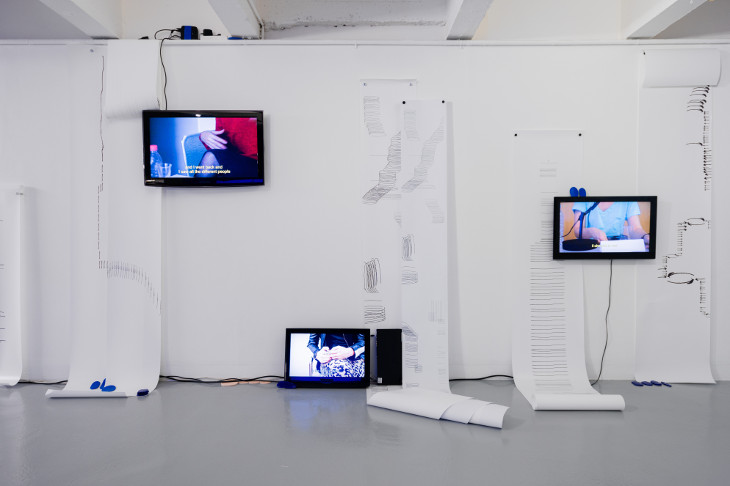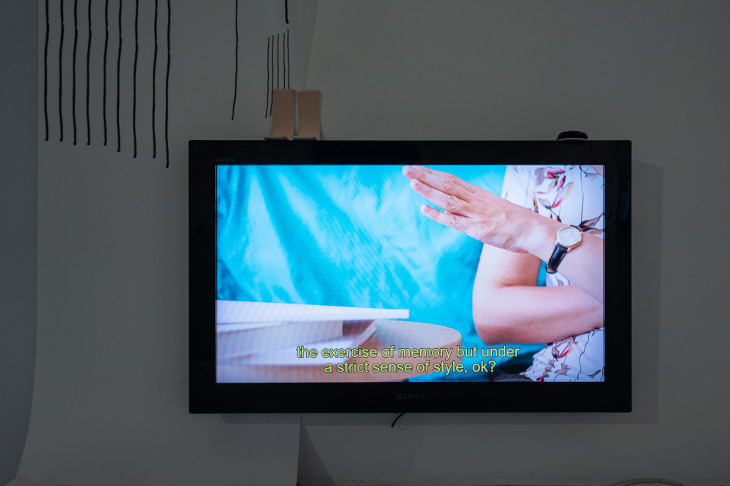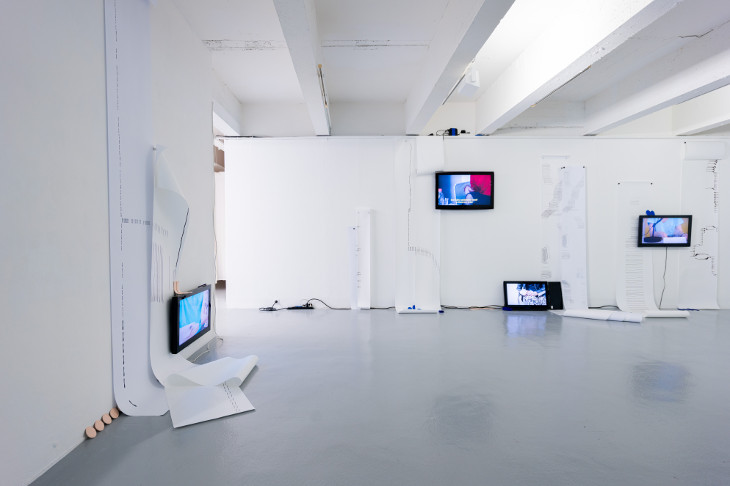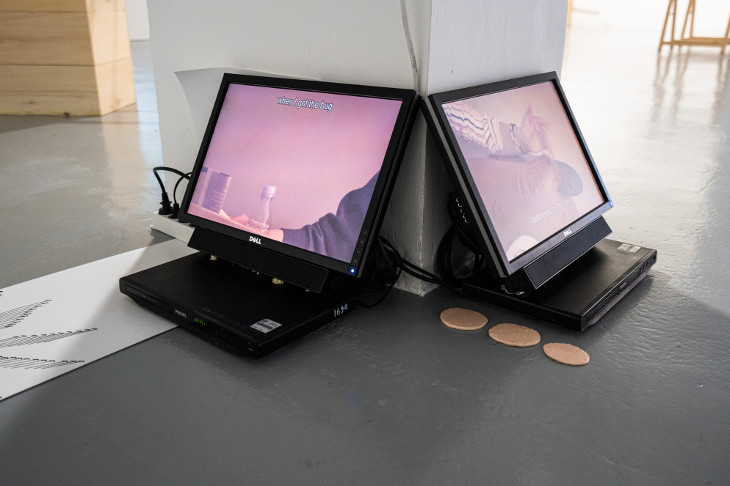The Intolerable Straight Line
Maíra Dietrich, Quoting, 2019
Video installation with printed paper, six screens, ceramics and felt
Quoting from: Roberto Bolaño (2001), Chris Kraus (2006), Kathy Acker (1986), Chantal Akerman (2006), Clarice Lispector (1977), Moyra Davey (2012).
The following is an interview with the artist conducted by Fleur Mothe Bardy, Alma Oskouei and Victoria Quesnel.
Could you please introduce your piece presented at the Galerie Art & Essai?
The work I’m preparing for the exhibition is a piece about quotation. In this piece, and in my work in general, I’m interested in language in relation to the body. The idea of quotation I use is not the one we formally use, quoting a written text and using quotation marks, I propose a bodily quotation. It departs from the practice of watching video interviews and presentations by artists, writers and other public figures and paying attention not only to speech, but to gesture, voice, gaze… The core of the piece I’m presenting is a selection of videos in which I quote these people by reenacting their gesture in a chosen scene of the source video. The selected parts were choses based on the strength of both the words and gesture.
Where does this desire for quoting come from? Does it come from an urge to embody somebody’s experience or is it a sort of tribute, an homage?
I believe it compiles both things; there is the desire to embody other’s words, knowledge, and attitude, plus the desire of keeping these names popping up. They are all people I admire and am intrigued by, people I want to keep visible, not only for myself but for others. The work itself is self referential, many quotes address the act of quoting itself. Together with the quoting gesture, the work combines broader interests not necessarily driven by the chosen people, including language as a bodily phenomena, the use of a work of art to go back and forth on time, the interview situation, moving image as a tool of dismantling time, and the intertwining of written and visual language…
In your artistic career, you maintain a close relationship with writing and literature, although you prefer to work with video and/or sound. Is there a reason to this choice?
It’s something that happened in my trajectory. My early works were usually written texts printed on paper, and as time came passed, that feeling of safe and still, well-behaving works started to bother me. It was not at all a conscious decision. Things happened, written language became more spacial through sound, more orchestrated through sound installations, bearing rhythm and image references with vídeo, which has been my recent medium, maybe not video itself, but mainly video and sound editing.
Does fiction occupy a place in your practice? Do you try to create fictional situations or does your use of language only serve to document real situations?
Fiction has always been natural for me, it forms the basis of my reading and seeing material. I work with the idea of fiction as versions of reality, as if things could or maybe will happen this way. By practicing possibilities we work on our ability to imagine solutions, behaviors, to speculate, to forecast… therefore we practice reality. My work builds on this idea of versions of reality, dissecting simple phenomena, like writing, hearing, spelling, seeing, reenacting. Not necessarily real events but real phenomena.
What does “Translation” mean to you? Which dimension of “translation” do you think is visible in your work?
In my early work, the notion of translation was a term I addressed many works to. Little by little, the term shifted from a position of subject to a position of methodology. In a broader sense, being a translator means possessing enough codes to interpret and create something new based on what you interpreted. So when I say ‘translation’ in my work is rarely an abstract notion, eligible for verbal language-based processes only, it’s a function we practice on a daily basis, reinterpreting knowledge, stories, notions, works of art, behavior, and building anew. The same goes for editing as methodology, the building of selection, emphasis, timing, positioning…
You mainly express yourself in Portuguese, your mother tongue. How do you adapt your work to other languages? How do you overcome the barriers of language? Do you think a new language gives new possibilities and dimensions to your work?
I have always been interested in learning how different languages operate and what is the basis of their construction. From these specificities there’s always something you can understand about language in general. The most recent case I experienced was to write a thesis in English, it cost somewhat of a surrender to another language, meaning to store brazilian-portuguese away. That made me see my language from a new perspective, not only the internal constructions but the sounds, the waving of phonemes, it was the kind of experience I could have only by not having it for a while. In general I never really see language issues as barriers, all the situations I remember of not understanding or not being understood taught me a great deal, it’s also a way of practicing language in depth. My work feeds a lot from these situations, scrutinizing details, anecdotes, and words.
How was it to work in the context of a research program, i.e with a group of artists and researchers?
I think the specificity the Art by Translation program builds is that of artists developing research together. In the case of this exhibition, we have been working on our individual projects and discussing them closely for the past months. This gives the space to build together the concepts and works for the exhibition and the program in general. It implies an openness, we all have to propose and think space/context/format together. It’s very rewarding to see how our individual researches naturally converge, based on healthy contaminations between ideas and works, with contributions we give and receive from one another, sharing references, opinions, solutions.
An interview conducted by Fleur Mothe Bardy, Alma Oskouei and Victoria Quesnel (seminar “Listening to the Archives”, Master of Fine arts, Université Rennes 2).



